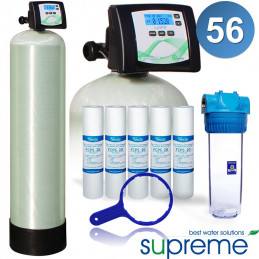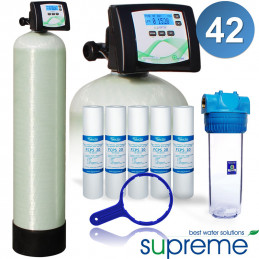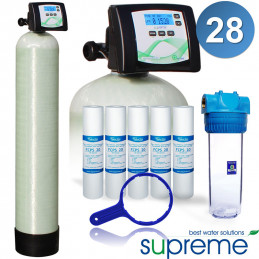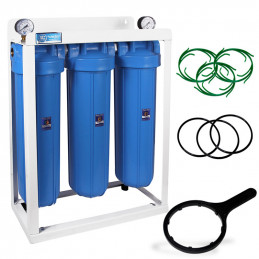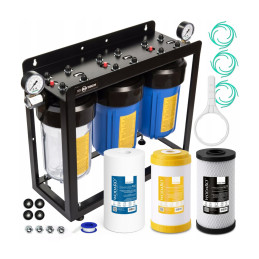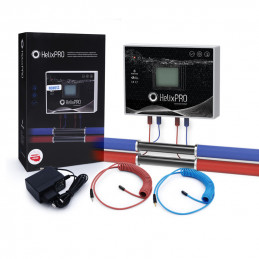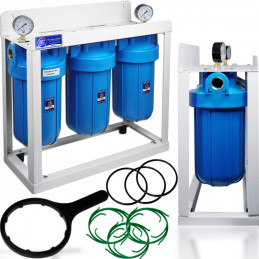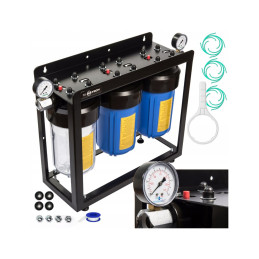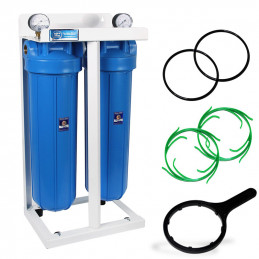- There are no more items in your cart
- Shipping
- Total zł0.00
- Bestsellers
- Hurt
- Water filters
- Whole house filters
- Kitchen filters
- Bathroom filters
- Aquarium filters
- Reverse osmosis
- Water demineralizers
- Filter cartridges
- UV bactericidal lamps
- Alkaline water ionizers
- Industrial water filters
- Accessories, parts, and others
- Descaling filters for the coffee machine
- Water softeners and iron removers
- Water saturators
- ACES
- AMBERLITE
- AQUA VITA
- AQUAFILTER
- AQUAPHOR
- AQUATOR
- BASSAU
- BERG
- BIOCERA
- BIONIQ
- BLUEFILTERS
- CHEMOFORM
- CINTROPUR
- DAFI
- DELONGHI
- DIAMOND
- DOM WODY
- ECOWATER
- FILMTEC
- FIT ALCO
- FITAQUA
- GREEN FILTER
- HANNA INSTRUMENTS
- HELIXPRO
- HELLO PURE
- HIDROTEK
- HM-DIGITAL
- HONEYWELL
- JAVEL
- KLARWOD
- KRUPS
- MIDEA
- OTOWODA
- OTTONE
- Palintest
- PENTAIR
- PHILIPS
- PLATINUM WASSER
- PUROLITE
- SIEMENS
- SUPREME
- TAB-SOL
- TOP FILTER
- UST-M
- USTM
- VONTRON
- WODARO
Porady
Uzdatniacze wody bez soli | Zmiękczacze i Odżelaziacze
Uzdatnianie wody przechodzi prawdziwą rewolucję – coraz częściej stawia się na nowoczesne i ekologiczne rozwiązania. Jednym z nich jest stacja uzdatniania wody bez soli, która pomaga skutecznie walczyć z problemem twardej wody i nadmiarem żelaza, a przy tym nie wymaga stosowania soli tabletkowanej. Poznaj zasady działania, zalety oraz możliwości bezsolnych zmiękczaczy i odżelaziaczy wody.
Filtruj
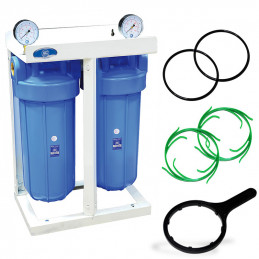
HHBB10A Aquafilter double big blue 10" water filter
What is a salt-free and chemical-free water treatment station?
A salt-free water treatment station is an innovative device that – unlike traditional softeners – does not require the addition of salt tablets. Thanks to specialized media or physical technologies (e.g., catalytic or electromagnetic impulse), such an installation helps reduce scale buildup and, with the right configuration, also removes excess iron. Most importantly, everything is done in an environmentally friendly manner, generating no salty wastewater.
Why choose a salt-free water softener instead of a traditional one?
Choosing a salt-free and chemical-free water softener primarily means:
-
Ecology and savings: The lack of need to replenish salt means lower expenses and less burdensome operation.
-
Less waste: Salt-free devices do not produce brine discharges, which positively impacts the environment and the sewage system.
-
Minimal interference with the installation: Salt-free softeners usually do not require additional salt tanks or complicated connections.
-
Multifunctionality: Salt-free solutions can simultaneously soften water (reducing the risk of scale formation) and remove iron or manganese, depending on the media used.
How do salt-free water treatment stations work?
The primary task of salt-free stations is to improve water quality by changing the structure of the ions responsible for hardness (mainly calcium and magnesium) and – in some configurations – removing excess iron. Instead of ion exchange (used in classic softeners), physical or catalytic phenomena are employed here, which limit the ability to deposit scale and allow the transformation of dissolved compounds into forms that are less burdensome for the installation.
Salt-free water softener – catalytic technology
What does the catalytic process involve?
In the catalytic process, hardness molecules (calcium and magnesium) crystallize into a form that does not adhere to the surfaces of pipes or household appliances. A special catalytic medium "attracts" the ions and initiates a change in their structure. As a result, the water is less prone to sediment formation, and its flow is not restricted by accumulated scale.
Types of catalytic media:
-
Crystallizing media: Modify water hardness without removing minerals, allowing the water to retain its natural properties.
-
Multifunctional media: In addition to catalysis, they can partially capture certain metals and other contaminants.
Salt-free water softener – electromagnetic treatment
How does the electromagnetic field affect water?
In salt-free electromagnetic systems, water flows through a chamber where it interacts with a specially generated magnetic field. This modifies the form of the ions responsible for hardness – as a result, scale is more difficult to precipitate and deposit on fixtures.
Advantages of magnetic technology
-
Easy installation in the system, often requiring just a small device that wraps around the pipe.
-
No need for regular replacement of cartridges or replenishing media.
-
Strictly physical operation – does not change the chemical composition of the water, which can be beneficial for households or installations sensitive to additional substances.
Polyphosphate media
Although in classic water softeners the addition of polyphosphates aims to bind hardness ions, in the case of salt-free treatment stations, water can be treated with small amounts of polyphosphates. Some experts believe that a fully "salt-free" installation should rely more on physical or catalytic methods. Polyphosphates can help mitigate the effects of water hardness, but they require regular replenishment and are more of an addition than a standalone solution in salt-free systems.
Mechanical filter media (Turbidex, filter sand)
Many users opt for additional mechanical media, such as Turbidex or filter sand, to remove solid contaminants (e.g., rust particles, sand, or silt) from the water. Such media in salt-free stations support the operation of the main technologies (catalytic, electromagnetic) and also improve the clarity and purity of water - especially in cases of high turbidity.
The biggest advantages and disadvantages of salt-free water softening
Like any solution, a water softener without salt has both strengths and weaknesses. It is worth taking a closer look at them before making a final decision.
-
Advantages
-
No need to purchase and store salt and chemicals.
-
No brine wastewater, which is environmentally friendly.
-
Easier and cheaper operation in the long run.
-
The ability to retain valuable minerals in the water.
-
-
Disadvantages
-
Effectiveness in very high water hardness may be somewhat limited compared to classic ion-exchange softeners.
-
Some technologies require careful technical selection for specific water quality (e.g., chemical composition, pH level).
-
Sometimes additional filters need to be applied (e.g., for strong removal of iron or manganese).
-

Is a salt-free softener effective?
Effectiveness compared to salt-based softeners
A chemical-free and salt-free water softener can successfully minimize the problem of scale, although in some situations the effect may not be as intense as with devices based on ion exchange. Nevertheless, if your goal is to protect household appliances, installations, and eliminate minor deposits, salt-free water softening stations work excellently.
User reviews and practical examples
Many single-family homeowners praise the reduction of scale in kettles and shower cabins. Benefits are also noticeable in laundries or gastronomy – heating elements and nozzles do not clog as easily as with hard water. The best results are achieved by selecting the device to the specific parameters of the water and the needs of the household.
Iron removal from water without salt – an effective alternative
When water contains an excessive amount of iron, it can lead to unpleasant taste, staining of sanitary ware, or discoloration in laundry. A solution can be a salt-free iron remover, which removes or reduces iron without the need for regenerating salt. This provides an ecological and comfortable alternative to classic iron removal methods.
How does a salt-free and chemical-free iron remover work?
Salt-free iron removers can utilize a catalytic bed that accelerates the oxidation of iron and precipitates it from water. Then, solid particles are retained on the filtration bed or flushed away during cyclic rinsing. These methods are often supported by preliminary aeration, which further promotes the oxidation processes of iron.
Benefits of iron removal without using salt
By choosing a salt-free water iron remover, you gain:
-
Eco-friendly approach: No brine in wastewater.
-
Lower operating costs: No need to purchase regeneration salt.
-
Simpler operation: Fewer maintenance tasks compared to traditional iron removers.
-
Versatility: Ability to combine with technologies that simultaneously reduce hardness, manganese, or other compounds.
Application of salt-free water treatment devices in households
Salt-free devices are effective in homes where owners want to reduce issues related to hard water or excess iron without burdening the environment. Their simplicity and versatility make them an attractive choice for those who value comfort and savings.
Salt-free water treatment devices for single-family homes - Benefits
-
Reduction of limescale buildup in showers, household appliances, and heating systems.
-
Protection of the plumbing system from corrosion and narrowing of pipe diameters.
-
Improvement of water usability (fewer stains and streaks on fixtures).
Operational savings:
-
No cyclical purchase of heavy (usually 25kg) bags of salt.
-
Avoidance of costly repairs related to iron or limescale deposits.
-
Lower energy consumption in heating appliances (water heaters, washing machines) because heating elements do not become coated with limescale.
When is it particularly worth choosing a salt-free treatment device?
-
When brine or strong chemicals cannot be used
Some local regulations or sewage conditions prevent the discharge of salty wastewater. -
With sensitive sanitary installations
A traditional softener can alter the ion ratios in water, which can be problematic in certain systems. A salt-free softener is a gentler alternative in such cases. -
In case of limited space
The absence of an additional brine tank saves space, which can be crucial in small boiler rooms or narrow utility rooms.
How to choose a salt-free water treatment device?
The selection of the appropriate model primarily depends on the type and concentration of contaminants in the water (hardness, iron, and manganese content) and the water demand in the household. It is advisable to conduct a water parameter analysis to perfectly match the device to your needs.
What to pay attention to when choosing?
-
Analysis of water test results in the case of wells:
Perform a water test and determine the hardness level, iron content, manganese, pH, turbidity, nitrates, and nitrites. -
Choosing a device based on water consumption
Pay attention to the performance of the station – it must meet the maximum instantaneous demand in your home. -
Individual household needs
Check whether you are more concerned about reducing limescale or rather about removing iron and other contaminants.
Common mistakes when selecting salt-free devices
-
Too low performance
If the device is too small relative to actual water consumption, it will not deliver the expected results. -
Incorrectly matching technology to the problem
Water with high iron content requires support, e.g., in the form of water treatment devices with aeration or a catalytic bed. Without this, the results may be unsatisfactory.
Installation and maintenance of salt-free treatment devices – what you need to know?
Installing salt-free treatment devices is usually simpler than for systems requiring brine regeneration. However, it is important to carry it out according to the manufacturer's recommendations and perform necessary service tasks.
Installation of a salt-free treatment device – step by step
-
Where is the best place to install the device?
It is recommended to install it on the main water supply line, before the water reaches the distribution system (e.g., behind the water meter). -
What are the installation requirements?
Appropriate water pressure must be ensured, access to power (for electromagnetic models), and space for a possible drain to the sewage system if bed rinsing is needed.
Maintenance and servicing of salt-free and chemical-free treatment devices.
-
Frequency of inspections
Depending on the type of bed or technology, manufacturers recommend inspections every 12 months. Beds in stations are replaced every few/ten years, while filter cartridges are usually every 6 months. -
Basic service tasks
-
Periodic replacement of cartridges in inline filters (if used before or after the station).
-
Rinsing the bed in treatment stations (especially in the case of catalytic or mechanical solutions).
-
Quality control of water to verify the effectiveness of the system.
-
Frequently asked questions about salt-free water treatment devices (FAQ)
-
Does a salt-free treatment device completely remove limescale?
It does not always remove it 100% like traditional ion-exchange softeners, but it significantly reduces its formation. The technology involves changing the form of minerals, which minimizes limescale buildup. -
What does a water treatment device with aeration filter?
An aeration treatment station allows for better oxidation of iron and its removal as sediment, as well as supports the manganese reduction process. The aerated water is less susceptible to contaminants typical of groundwater (iron, hydrogen sulfide). -
Is water from a salt-free treatment device suitable for drinking?
It depends - salt-free technologies do not introduce additional chemicals, but it is necessary to ensure that the technology can handle troublesome contaminants. -
How much does it cost to operate a salt-free treatment device?
Definitely less than in systems requiring salt. There is no regular purchase of salt tablets, and servicing mainly involves inspections and possible bed rinsing.
Why is it worth buying a salt-free water treatment device from us?
In our store, we focus on the highest quality and professional advice. We offer many stations, including water iron removers with aeration, which effectively eliminate excess iron. We guarantee:
-
Expert assistance in selecting devices to meet individual needs.
-
A wide selection of proven solutions from reputable manufacturers.
-
Attractive prices and favorable delivery conditions.
-
Comprehensive service support and quick contact in case of questions.

Summary
Undoubtedly, a salt-free water treatment station is a forward-looking and ecological solution that is increasingly chosen as an alternative to ion exchange systems. By utilizing physical phenomena, catalysis, or aeration, these devices effectively reduce scale buildup and remove excess iron – all with minimal interference in the water composition. If you care about environmental protection, easy operation, and a noticeable improvement in quality of life, salt-free water softeners may be the ideal solution for your home.




